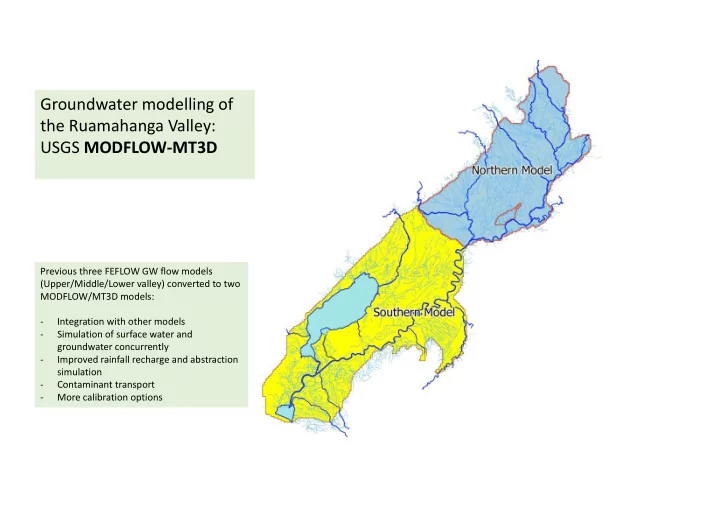

Groundwater modelling of the Ruamahanga Valley: USGS MODFLOW ‐ MT3D Previous three FEFLOW GW flow models (Upper/Middle/Lower valley) converted to two MODFLOW/MT3D models: ‐ Integration with other models ‐ Simulation of surface water and groundwater concurrently ‐ Improved rainfall recharge and abstraction simulation ‐ Contaminant transport ‐ More calibration options
Groundwater Model Inputs & Assumptions • Input 1: Physical structure: geology, layers, faults etc (FEFLOW) • Input 2: Rivers/streams/springs (TOPNET / Mike11) • Input 3: Rainfall recharge (IRRICALC) • Input 4: Groundwater and surface water abstraction (IRRICALC) • Input 5: Aquifer properties • Input 6: Nutrient loadings (Overseer ‐ MPI / Jacobs)
Input 1: Geology and structure – physical model set up Complex geology. Conceptualisations developed for the Feflow models – robust • work based upon best current levels of understanding using best expertise available. Assumptions – there are numerous assumptions and simplifications in the • geological conceptualisations due to the highly complex and heterogeneous geological environment. This is unavoidable. Assumptions tested during the Feflow calibrations – the groundwater system • behaves as a single leaky system. The groundwater model probably least sensitive to assumptions made for Input 1. A highly interconnected groundwater system – which has strong connectivity to • surface water = basis for conjunctive sw/gw allocation management approach
Input 1: Geology/physical system structure
Input 2: Rivers/streams/springs – physical model set up Modflow’s SFR module (Stream Flow Routing) is a fundamental modelling component which • simulates channel flow and the interaction between surface water and groundwater. TOPNET feeds water into the SFR segments where rivers/streams enter the plains • Surface water courses set up using GWRC bed survey and river cross ‐ section data (MIKE 11). • SFR also simulates contaminant transport between groundwater and surface water. • A big improvement over Feflow with regards its flexibility to integrate with other models. • SFR handles inputs from overland flow/runoff, surface water abstractions (provided by • Irricalc), diversions to water races. Assumptions: Few flow monitoring sites on the plains for calibration; quite a few synthetic • flow sites based upon calculated relationships. Spatial resolution ‐ SFR set up using segments of about 2km length for major rivers – water balances therefore lumped for each segment.
SFR segments – Northern Model (showing Topnet inputs at model boundary and water race injection nodes)
SFR segments – Southern Model (also showing water race injection nodes)
Inputs 3 and 4: Rainfall recharge and irrigation demand (IRRICALC) Rainfall recharge externally calculated using a soil moisture balance model (IRRICALC). Similar methodology • to the previous feflow models although Irricalc is a more integrated soil water balance model which incorporates irrigation water demand and runoff. Irricalc requires input data: climate (rainfall and potential evapotranspiration), crop (crop factors, rooting • depths) and soil (soil water holding capacity) data. Provided by NIWA and Landcare Research. Recharge has been calculated using the same 500m grid and distributed input daily data rainfall and PET • series as used in the previous Feflow models (1992 to present). Irricalc has been used to model historic irrigation abstraction rates based upon crop water demand. These • demands have been incorporated into the model calibration (either as surface water or groundwater abstractions) Assumptions: Recharge calculated using soil moisture balance models assumes a free ‐ draining soil; • recharge is applied directly to the water table/aquifer and does not take into account unsaturated zone properties/lags or short ‐ circuits; irrigation demands assume certain irrigation practices/rules and land use; water is always available for irrigation at the rate required; assumptions concerning irrigation returns; assumptions concerning partitioning of runoff/interflow and groundwater recharge.
Irricalc recharge
Input 5: Aquifer properties (hydraulic conductivity and storage) Aquifer properties are based upon the previous Feflow models – which relied upon field ‐ measured • transmissivity/storage data (starting values in MODFLOW – will be refined during calibration). Model values are restricted to field ‐ measured ranges (pumping tests). • Model calibration allows for a more distributed/heterogeneous distribution of parameters – derived • through the calibration process. Assumptions – areas where no data exist – but nature of geology provides a good guide. Natural system is • highly heterogeneous so simplifications need to be made: model parameter estimation and uncertainty analysis will interrogate assumptions in terms of their effect on model predictive reliability.
Groundwater Model Outputs & Assumptions • Output 1: Groundwater levels • Output 2: Stream flows • Output 3: Stream – groundwater fluxes • Output 4: Nitrate concentrations Model calibration is currently being revised due to new TOPNET and Nitrate model input files supplied.
Assumptions: Groundwater levels Weekly stress periods • 5 model layers in the north • 8 model layers in the south • Pilot point parameters x original Feflow • parameter zones Irricalc estimated recharge, abstraction, and • quickflow Topnet estimated inflows to model •
Output 1: Groundwater levels
Output 2: Stream flows Assumptions: Stream flows Weekly stream flows used as calibration • targets Irricalc estimated recharge, abstraction, and • quickflow Topnet estimated inflows to model •
Output 2: Stream flows
Output 2: Stream flows
Output 3: Stream – groundwater fluxes
Output 4: Nitrate concentrations Assumptions: Groundwater concentrations Annual average nitrate input into model from • Overseer Average nitrate concentration in surface water • ways as input into model (will iterate with Esource for final model version) 5 model layers in the north • 8 model layers in the south • Calibrated to average nitrate concentrations in • groundwater (monitoring period dependant) Pending new nitrate inputs…
Used 0.5 for initial condition
Recommend
More recommend